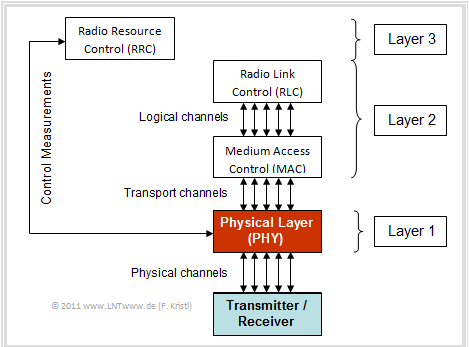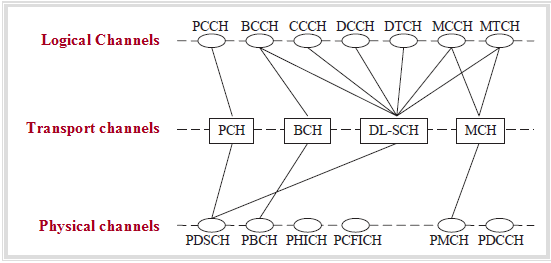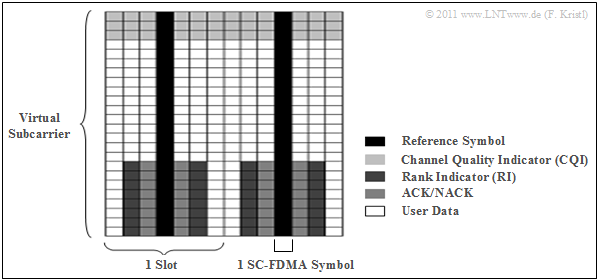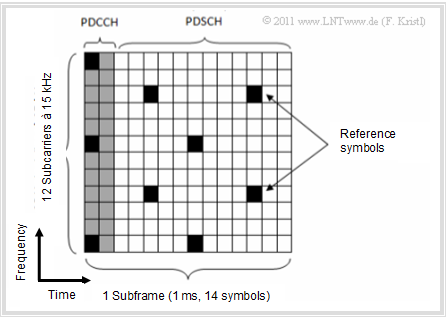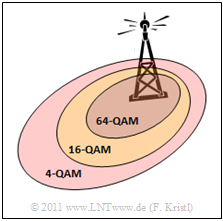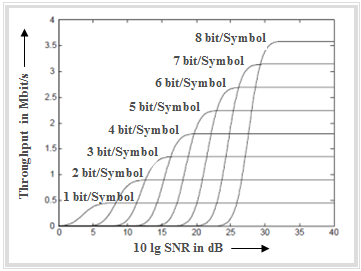Difference between revisions of "Mobile Communications/Physical Layer for LTE"
| Line 6: | Line 6: | ||
}} | }} | ||
| − | == | + | == General Description== |
<br> | <br> | ||
| − | + | The <i>Physical Layer</i> is the lowest layer in the OSI–layer model of the <i>International Organization for Standardization</i> (ISO), which is also called <i>Bit transmission layer</i> . It describes the physical transmission of bit sequences in LTE and the operation of the various channels according to the 3GPP–specification. All specifications are valid for ''Frequency Division Duplex'' (FDD) as well as for ''Time Division Duplex'' (TDD). | |
| − | [[File:EN_LTE_T_4_4_S1b_v1.png|right|frame| | + | [[File:EN_LTE_T_4_4_S1b_v1.png|right|frame|Protocol Architecture for LTE|class=fit]] |
| − | + | The diagram shows the layers of the LTE–protocol architecture. The communication between the individual layers takes place via three different types of channels: | |
| − | * | + | *Logical channels,<br> |
| − | * | + | *Transport channels,<br> |
| − | * | + | *physical channels. <br><br> |
| − | + | This chapter deals with the communication between sender and receiver in the lowest, red highlighted <i>physical layer</i>. | |
| − | + | Basically it should be noted: | |
| − | * | + | *Exactly like the Internet, LTE uses exclusively packet-based transmission, i.e. without specifically assigning resources to a single user.<br> |
| − | * | + | *The design of the LTE–physical layer is therefore characterized by the principle of dynamically allocated network resources.<br> |
| − | * | + | *The physical layer plays a key role in the efficient allocation and utilization of available system resources. |
| − | + | According to this graphic the physical layer communicates with | |
| − | * | + | *the block <i>Medium Access Control</i> (MAC) and exchanges information about the users and the regulation or control of the network via so-called transport channels,<br> |
| − | * | + | *the block <i>Radio Resource Control</i> (RRC), where control commands and measurements are continuously exchanged to adapt the transmission to the channel quality.<br><br> |
| − | + | The complexity of the LTE–transmission is to be indicated by the following diagram, which has been directly adopted by the <i>European Telecommunications Standards Institute</i> (ETSI). It shows the communication between the individual layers (channels) and applies exclusively to the downlink.<br> | |
| − | [[File:EN_LTE_T_4_4_S1.png|right|frame| | + | [[File:EN_LTE_T_4_4_S1.png|right|frame|Communication between the individual layers in the LTE downlink|class=fit]] |
| − | * | + | *On the following pages we will take a closer look at the physical layer and the physical channels. We distinguish between uplink and downlink, but we will limit ourselves to the essentials. |
| − | *In | + | *In reality, the individual channels take over a number of other functions, but their description would go beyond the scope of this tutorial. |
| − | * | + | *If you are interested, you can find a detailed description in [HT09]<ref name= 'HT09'>Holma, H.; Toskala, A.: ''LTE for UMTS - OFDMA and SC-FDMA Based Radio Access.'' Wiley & Sons, 2009.</ref>. |
<br clear=all> | <br clear=all> | ||
| − | == | + | == Physical channels in uplink== |
<br> | <br> | ||
| − | LTE | + | LTE uses the multiple access method [[Mobile_Communications/The_Application_of_OFDMA_and_SC-FDMA_in_LTE#Functionality_of_SC.E2.80.93FDMA|SC–FDMA]] in the uplink transmission from the terminal device to the base station. Accordingly, the following physical channels exist in the 3GPP–specification: |
*<i>Physical Uplink Shared Channel</i> (PUSCH),<br> | *<i>Physical Uplink Shared Channel</i> (PUSCH),<br> | ||
*<i>Physical Random Access Channel</i> (PRACH),<br> | *<i>Physical Random Access Channel</i> (PRACH),<br> | ||
*<i>Physical Uplink Control Channel</i> (PUCCH).<br><br> | *<i>Physical Uplink Control Channel</i> (PUCCH).<br><br> | ||
| − | |||
| − | + | The user data are transmitted in the physical channel '''PUSH''' . The transmission speed depends on how much bandwidth is available to the user at that moment. The transmission is based on dynamically allocated resources in time and frequency range with a resolution of one millisecond or 180 kHz.This allocation is performed by the [[Mobile_Communications/Physical_Layer_for_LTE# Scheduling for LTE| Scheduler]] in the base station (<i>eNodeB</i> ). A terminal device cannot transmit any data without instructions from the base station.<br>. | |
| − | + | The exception is the use of the physical channel '''PRACH'', the only channel in the LTE–uplink with non–synchronized transmission. The function of this channel is the request for permission to send data via one of the other two physical channels. By sending a <i>Cyclic Prefix</i> and a signature on the PRACH, the terminal and base station are synchronized and are thus ready for further transmissions.<br> | |
| − | |||
| − | * | + | The third uplink–channel '''PUCCH''' is used exclusively for the transmission of control signals. By this one understands |
| + | *positive and negative acknowledgements of receipt (ACK/NACK),<br> | ||
| − | * | + | *Requests for repeated transmission (in case of NACK), and<br> |
| − | + | *the exchange of channel quality information between the terminal and the base station.<br><br> | |
| − | + | If, in addition to the control data, user data is sent from the terminal to the base station at the same time, such control signals can also be transmitted via the PUSCH. If no user data is to be transmitted, PUCCH is used instead.<br> | |
| − | |||
| − | + | A simultaneous use of PUSCH and PUCCH is not possible due to restrictions of the SC–transmission method SC–FDMA. If only one <i>Shared Channel</i> had been selected for all control information, one would have had to choose between | |
| + | *intermittent problems with user data transmission, or<br> | ||
| − | + | *permanently too few resources for the control information.<br><br> | |
| − | * | + | |
| + | The information about the channel quality is obtained by means of so-called reference symbols. As indicators for the channel quality this information is then sent | ||
| + | *to <i>Channel Quality Indicator</i> (CQI), and<br> | ||
| + | |||
| + | *to <i>Rank Indicator</i> (RI).<br><br> | ||
| + | |||
| + | A detailed explanation of the quality guarantee can be found, for example, in [HR09]<ref name='HR09'>Homayounfar, K.; Rohani, B.: ''CQI Measurement and Reporting in LTE: A New Framework.'' | ||
| + | IEICE Technical Report, Vol. 108, No. 445, 2009.</ref> and [HT09]<ref name='HT09'></ref>.<br> | ||
| − | |||
| − | |||
| − | |||
{{GraueBox|TEXT= | {{GraueBox|TEXT= | ||
| − | $\text{ | + | $\text{Example 1:}$ The reference symbols or channel quality information are distributed in the PUSCH according to the following graphic. |
| − | [[File:EN_LTE_T_4_4_S2.png|center|frame| | + | [[File:EN_LTE_T_4_4_S2.png|center|frame|distribution of reference symbols and user data in PUSCH|class=fit]]. |
| − | + | This describes the arrangement of the useful information and the signaling data in a "virtual" subcarrier. | |
| − | * | + | *Virtual because SC–FDMA does not have subcarriers like OFDMA. |
| − | * | + | *The reference symbols are necessary to estimate the channel quality.<br> |
| − | * | + | *This information is also transferred as <i>Channel Quality Indicator</i> (CQI) or as <i>Rank Indicator</i> (RI) via the PUSCH.}}<br><br> |
| − | == | + | == Physical channels in downlink== |
<br> | <br> | ||
| − | + | In contrast to the uplink, LTE uses the multiple access method [[Mobile_Communications/The_Application_of_OFDMA_and_SC-FDMA_in_LTE#Differences_between_OFDMA_and_SC.E2.80.93FDMA|OFDMA]] in the downlink, i.e. during transmission from the base station to the terminal. Accordingly, the 3GPP–Consortium specified the following physical channels for this purpose: | |
*<i>Physical Downlink Shared Channel</i> (PDSCH),<br> | *<i>Physical Downlink Shared Channel</i> (PDSCH),<br> | ||
| Line 103: | Line 106: | ||
*<i>Physical Multicast Channel</i> (PMCH).<br><br> | *<i>Physical Multicast Channel</i> (PMCH).<br><br> | ||
| − | + | The user data are transmitted via the '''PDSCH''' . The resource allocation is done both in the time domain (with a resolution of one millisecond) and in the frequency domain (resolution: 180 kHz). Due to the use of OFDMA as transmission method, the individual speed of each user depends on the number of assigned resource blocks (à 180 kHz). A <i>eNodeB</i> allocates the resources related to the channel quality of each individual user.<br> | |
| − | + | The '''PDCCH''' contains all information regarding the allocation of resource blocks or bandwidth for both the uplink and the downlink. A terminal device thereby receives information about how many resources are available.<br>. | |
| − | [[File:EN_LTE_T_4_4_S3.png|right|frame| | + | [[File:EN_LTE_T_4_4_S3.png|right|frame|Division between PDCCH and PDSCH in LTE downlink]] |
| − | + | The diagram shows an example of the division between the channels PDCCH and PDSCH: | |
| − | * | + | *The PDCCH can occupy up to four symbols per subframe (in the graphic: two).<br> |
| − | * | + | *This leaves twelve time slots for the user data (i.e. for the channel PDSCH). |
| − | + | Via channel '''PCFICH''' the terminal device is informed how many symbols are to be assigned to the control information of the PDCCH. The purpose of this dynamic division between control– and user data is as follows: | |
| − | * | + | *On the one hand, many users can be supported in this way, each with a low data rate. This scenario requires more tuning, which means that in this case the PDCCH would have to contain three or four symbols.<br> |
| − | * | + | *On the other hand, the overhead caused by PDCCH can be reduced by assigning a high data rate to only a few concurrent users. |
| − | [[File:EN_LTE_T_4_4_S3b.png|left|frame| | + | [[File:EN_LTE_T_4_4_S3b.png|left|frame|Distribution of reference symbols in the downlink|class=fit]] |
<br><br><br><br><br><br><br> | <br><br><br><br><br><br><br> | ||
| − | + | In addition to the PDCCH, reference symbols are also required in the downlink to estimate the channel quality and calculate the <i>Channel Quality Indicator</i> (CQI) . These reference symbols are distributed over the subcarriers (different frequencies) or symbols (different times) as shown in the adjacent figure. | |
<br clear=all> | <br clear=all> | ||
| − | + | Regarding the other physical channels of the LTE–Downlink is to be noted: | |
| − | * | + | *The only purpose of the downlink–channel '''PHICH''' (<i>Physical Hybrid ARQ Indicator Channel</i> ) is to signal whether a packet sent in the uplink has arrived.<br> |
| − | * | + | *On the broadcast–channel '''PBCH''' (<i>Physical Broadcast Channel</i> ) the base stations send system information with operating parameters as well as synchronization signals, which are required for registration in the network, to all mobile terminals in the radio cell approximately every 40 milliseconds.<br> |
| − | * | + | *The Multicast–channel '''PMCH''' (<i>Physical Multicast Channel</i> ) has a similar purpose, information for so-called Multicast–transmissions – is sent to several receivers simultaneously through this channel. This could be, for example, mobile television via LTE, which is planned for a future release, or something similar.<br> |
| − | == | + | == Processes on the physical layer== |
<br> | <br> | ||
| − | + | By "processes in the physical layer" one understands different methods and procedures, which are used in the bit transmission layer. Among them fall among other things: | |
*<i>Timing Advance</i>,<br> | *<i>Timing Advance</i>,<br> | ||
| Line 145: | Line 148: | ||
*<i>Hybrid Adaptive Repeat and Request</i>.<br><br> | *<i>Hybrid Adaptive Repeat and Request</i>.<br><br> | ||
| − | + | A complete list with the corresponding description can be found in [HT09]<ref name='HT09'></ref>. Only the last two procedures will be discussed in more detail here.<br><br>. | |
| − | == | + | == Power control with LTE== |
<br> | <br> | ||
| − | + | By <i>Power Control</i> one understands generally the control of the transmission power with the goal, | |
| − | * | + | *to improve the transmission quality,<br> |
| + | |||
| + | *to increase the network capacity, and<br> | ||
| − | * | + | *reduce the power consumption.<br><br> |
| − | * | + | With regard to the last point, the standardization of LTE had to take this into account: |
| + | *On the one hand, the power consumption in the end devices was to be minimized in order to guarantee longer battery runtimes for them.<br> | ||
| − | + | *On the other hand, it should be avoided that the base stations have to provide too much power.<br><br> | |
| − | * | ||
| − | + | With LTE, <i>Power Control</i> is only applied in the uplink, whereas it is more of an "slow" power control. This means that the procedure specified in LTE does not have to react as quickly as for example in UMTS (<i>W–CDMA</i> ). The reason is that by using the orthogonal carrier system "SC–FMDA" the so-called [[Examples_of_Communication_Systems/Nachrichtentechnische_Aspekte_von_UMTS#Near.E2.80.93Far.E2.80.93Effekt| Near–Far–Problem]] does not exist. | |
| − | + | *To be precise, for LTE the <i>Power Control</i> does not control the absolute power, but the spectral power density, i.e. the power per bandwidth.<br> | |
| − | * | + | *Instead of trying to smooth power peaks by temporarily reducing the transmission power, power peaks can also be used to increase the data rate for a short time.<br><br> |
| − | + | All in all, LTE–power control is intended to find the optimum balance between the lowest possible power and at the same time interference that is still acceptable for the transmission quality (QoS). This is specifically achieved by estimating the loss during transmission and by calculating a correction factor according to the current site characteristics. The statements made here are largely taken from [DFJ08]<ref name ='DFJ08'>Dahlman, E., Furuskär A., Jading Y., Lindström M., Parkvall, S.: ''Key Features of the LTE Radio Interface.'' Ericsson Review No. 2, 2008.</ref>. | |
| − | |||
| − | == Hybrid Adaptive Repeat and Request == | + | === Hybrid Adaptive Repeat and Request == |
<br> | <br> | ||
| − | + | Every communication system needs a scheme for retransmission of lost data due to transmission errors to ensure sufficient transmission quality. In LTE <i>Hybrid Adaptive Repeat and Request</i> (HARQ) was specified for this purpose. This procedure is also used in [[Examples_of_Communication_Systems/Weiterentwicklungen_von_UMTS#HARQ.E2.80.93Verfahren_und_Node_B_Scheduling| UMTS]] in a similar form.<br> | |
| − | + | The procedure based on the <i>stop–and–wait</i>–technique is as follows: | |
| − | * | + | *After a terminal device has received a packet from the base station, it is decoded and feedback is sent via the [[Mobile_Communications/Physical_Layer_for_LTE#Physical channels in uplink| PUCCH]].<br> |
| − | * | + | *In case of a failed transmission ("NACK") the packet is resent. Only if the transmission was successful (Feedback: "ACK"), the next packet is sent.<br><br> |
| − | + | In order to ensure continuous data transfer despite the stop–and–wait–procedure, LTE requires several simultaneous HARQ–processes. In LTE, eight parallel processes are used both in the uplink and in the downlink.<br> | |
{{GraueBox|TEXT= | {{GraueBox|TEXT= | ||
| − | $\text{ | + | $\text{Example 2:}$ The graphic illustrates how it works with eight simultaneous HARQ–processes: |
| − | [[File:EN_LTE_T_4_4_S4a.png|center|frame|HARQ in LTE | + | [[File:EN_LTE_T_4_4_S4a.png|center|frame|HARQ in LTE with eight simultaneous processes|class=fit]] |
| − | * | + | *In this example, the first process fails in the first attempt to transfer packet 1. |
| − | * | + | *The receiver tells this "Fail" to the sender by a "NACK". |
| − | * | + | *In contrast, the second parallel process is successful with its first packet: "Pass".<br> |
| − | * | + | *In the next step (i.e. after the other seven HARQ–processes have sent) the first HARQ retransmits its last sent packet due to the acknowledgement "NACK" <br> |
| − | * | + | *The second process sends a new packet due to the acknowledgement "ACK" now.<br><br> |
| − | + | The other processes, which were ignored in this example, proceed in the same way.}}<br> | |
== Modulation bei LTE == | == Modulation bei LTE == | ||
Revision as of 14:46, 26 September 2020
Contents
General Description
The Physical Layer is the lowest layer in the OSI–layer model of the International Organization for Standardization (ISO), which is also called Bit transmission layer . It describes the physical transmission of bit sequences in LTE and the operation of the various channels according to the 3GPP–specification. All specifications are valid for Frequency Division Duplex (FDD) as well as for Time Division Duplex (TDD).
The diagram shows the layers of the LTE–protocol architecture. The communication between the individual layers takes place via three different types of channels:
- Logical channels,
- Transport channels,
- physical channels.
This chapter deals with the communication between sender and receiver in the lowest, red highlighted physical layer.
Basically it should be noted:
- Exactly like the Internet, LTE uses exclusively packet-based transmission, i.e. without specifically assigning resources to a single user.
- The design of the LTE–physical layer is therefore characterized by the principle of dynamically allocated network resources.
- The physical layer plays a key role in the efficient allocation and utilization of available system resources.
According to this graphic the physical layer communicates with
- the block Medium Access Control (MAC) and exchanges information about the users and the regulation or control of the network via so-called transport channels,
- the block Radio Resource Control (RRC), where control commands and measurements are continuously exchanged to adapt the transmission to the channel quality.
The complexity of the LTE–transmission is to be indicated by the following diagram, which has been directly adopted by the European Telecommunications Standards Institute (ETSI). It shows the communication between the individual layers (channels) and applies exclusively to the downlink.
- On the following pages we will take a closer look at the physical layer and the physical channels. We distinguish between uplink and downlink, but we will limit ourselves to the essentials.
- In reality, the individual channels take over a number of other functions, but their description would go beyond the scope of this tutorial.
- If you are interested, you can find a detailed description in [HT09][1].
Physical channels in uplink
LTE uses the multiple access method SC–FDMA in the uplink transmission from the terminal device to the base station. Accordingly, the following physical channels exist in the 3GPP–specification:
- Physical Uplink Shared Channel (PUSCH),
- Physical Random Access Channel (PRACH),
- Physical Uplink Control Channel (PUCCH).
The user data are transmitted in the physical channel PUSH . The transmission speed depends on how much bandwidth is available to the user at that moment. The transmission is based on dynamically allocated resources in time and frequency range with a resolution of one millisecond or 180 kHz.This allocation is performed by the Scheduler in the base station (eNodeB ). A terminal device cannot transmit any data without instructions from the base station.
.
The exception is the use of the physical channel 'PRACH, the only channel in the LTE–uplink with non–synchronized transmission. The function of this channel is the request for permission to send data via one of the other two physical channels. By sending a Cyclic Prefix and a signature on the PRACH, the terminal and base station are synchronized and are thus ready for further transmissions.
The third uplink–channel PUCCH is used exclusively for the transmission of control signals. By this one understands
- positive and negative acknowledgements of receipt (ACK/NACK),
- Requests for repeated transmission (in case of NACK), and
- the exchange of channel quality information between the terminal and the base station.
If, in addition to the control data, user data is sent from the terminal to the base station at the same time, such control signals can also be transmitted via the PUSCH. If no user data is to be transmitted, PUCCH is used instead.
A simultaneous use of PUSCH and PUCCH is not possible due to restrictions of the SC–transmission method SC–FDMA. If only one Shared Channel had been selected for all control information, one would have had to choose between
- intermittent problems with user data transmission, or
- permanently too few resources for the control information.
The information about the channel quality is obtained by means of so-called reference symbols. As indicators for the channel quality this information is then sent
- to Channel Quality Indicator (CQI), and
- to Rank Indicator (RI).
A detailed explanation of the quality guarantee can be found, for example, in [HR09][2] and [HT09][1].
$\text{Example 1:}$ The reference symbols or channel quality information are distributed in the PUSCH according to the following graphic.
.This describes the arrangement of the useful information and the signaling data in a "virtual" subcarrier.
- Virtual because SC–FDMA does not have subcarriers like OFDMA.
- The reference symbols are necessary to estimate the channel quality.
- This information is also transferred as Channel Quality Indicator (CQI) or as Rank Indicator (RI) via the PUSCH.
Physical channels in downlink
In contrast to the uplink, LTE uses the multiple access method OFDMA in the downlink, i.e. during transmission from the base station to the terminal. Accordingly, the 3GPP–Consortium specified the following physical channels for this purpose:
- Physical Downlink Shared Channel (PDSCH),
- Physical Downlink Control Channel (PDCCH),
- Physical Control Format Indicator Channel (PCFICH),
- Physical Hybrid ARQ Indicator Channel (PHICH),
- Physical Broadcast Channel (PBCH),
- Physical Multicast Channel (PMCH).
The user data are transmitted via the PDSCH . The resource allocation is done both in the time domain (with a resolution of one millisecond) and in the frequency domain (resolution: 180 kHz). Due to the use of OFDMA as transmission method, the individual speed of each user depends on the number of assigned resource blocks (à 180 kHz). A eNodeB allocates the resources related to the channel quality of each individual user.
The PDCCH contains all information regarding the allocation of resource blocks or bandwidth for both the uplink and the downlink. A terminal device thereby receives information about how many resources are available.
.
The diagram shows an example of the division between the channels PDCCH and PDSCH:
- The PDCCH can occupy up to four symbols per subframe (in the graphic: two).
- This leaves twelve time slots for the user data (i.e. for the channel PDSCH).
Via channel PCFICH the terminal device is informed how many symbols are to be assigned to the control information of the PDCCH. The purpose of this dynamic division between control– and user data is as follows:
- On the one hand, many users can be supported in this way, each with a low data rate. This scenario requires more tuning, which means that in this case the PDCCH would have to contain three or four symbols.
- On the other hand, the overhead caused by PDCCH can be reduced by assigning a high data rate to only a few concurrent users.
In addition to the PDCCH, reference symbols are also required in the downlink to estimate the channel quality and calculate the Channel Quality Indicator (CQI) . These reference symbols are distributed over the subcarriers (different frequencies) or symbols (different times) as shown in the adjacent figure.
Regarding the other physical channels of the LTE–Downlink is to be noted:
- The only purpose of the downlink–channel PHICH (Physical Hybrid ARQ Indicator Channel ) is to signal whether a packet sent in the uplink has arrived.
- On the broadcast–channel PBCH (Physical Broadcast Channel ) the base stations send system information with operating parameters as well as synchronization signals, which are required for registration in the network, to all mobile terminals in the radio cell approximately every 40 milliseconds.
- The Multicast–channel PMCH (Physical Multicast Channel ) has a similar purpose, information for so-called Multicast–transmissions – is sent to several receivers simultaneously through this channel. This could be, for example, mobile television via LTE, which is planned for a future release, or something similar.
Processes on the physical layer
By "processes in the physical layer" one understands different methods and procedures, which are used in the bit transmission layer. Among them fall among other things:
- Timing Advance,
- Paging,
- Random Access,
- Channel Feedback Reporting,
- Power Control,
- Hybrid Adaptive Repeat and Request.
A complete list with the corresponding description can be found in [HT09][1]. Only the last two procedures will be discussed in more detail here.
.
Power control with LTE
By Power Control one understands generally the control of the transmission power with the goal,
- to improve the transmission quality,
- to increase the network capacity, and
- reduce the power consumption.
With regard to the last point, the standardization of LTE had to take this into account:
- On the one hand, the power consumption in the end devices was to be minimized in order to guarantee longer battery runtimes for them.
- On the other hand, it should be avoided that the base stations have to provide too much power.
With LTE, Power Control is only applied in the uplink, whereas it is more of an "slow" power control. This means that the procedure specified in LTE does not have to react as quickly as for example in UMTS (W–CDMA ). The reason is that by using the orthogonal carrier system "SC–FMDA" the so-called Near–Far–Problem does not exist.
- To be precise, for LTE the Power Control does not control the absolute power, but the spectral power density, i.e. the power per bandwidth.
- Instead of trying to smooth power peaks by temporarily reducing the transmission power, power peaks can also be used to increase the data rate for a short time.
All in all, LTE–power control is intended to find the optimum balance between the lowest possible power and at the same time interference that is still acceptable for the transmission quality (QoS). This is specifically achieved by estimating the loss during transmission and by calculating a correction factor according to the current site characteristics. The statements made here are largely taken from [DFJ08][3].
= Hybrid Adaptive Repeat and Request
Every communication system needs a scheme for retransmission of lost data due to transmission errors to ensure sufficient transmission quality. In LTE Hybrid Adaptive Repeat and Request (HARQ) was specified for this purpose. This procedure is also used in UMTS in a similar form.
The procedure based on the stop–and–wait–technique is as follows:
- After a terminal device has received a packet from the base station, it is decoded and feedback is sent via the PUCCH.
- In case of a failed transmission ("NACK") the packet is resent. Only if the transmission was successful (Feedback: "ACK"), the next packet is sent.
In order to ensure continuous data transfer despite the stop–and–wait–procedure, LTE requires several simultaneous HARQ–processes. In LTE, eight parallel processes are used both in the uplink and in the downlink.
$\text{Example 2:}$ The graphic illustrates how it works with eight simultaneous HARQ–processes:
- In this example, the first process fails in the first attempt to transfer packet 1.
- The receiver tells this "Fail" to the sender by a "NACK".
- In contrast, the second parallel process is successful with its first packet: "Pass".
- In the next step (i.e. after the other seven HARQ–processes have sent) the first HARQ retransmits its last sent packet due to the acknowledgement "NACK"
- The second process sends a new packet due to the acknowledgement "ACK" now.
The other processes, which were ignored in this example, proceed in the same way.
Modulation bei LTE
LTE verwendet das Modulationsverfahren Quadratur–Amplitudenmodulation (englisch: Quadrature Amplitude Modulation, QAM). Dabei stehen sowohl im Uplink als auch im Downlink verschiedene Varianten zur Verfügung, nämlich
- 4–QAM (identisch mit QPSK) ⇒ 2 bit pro Symbol,
- 16–QAM ⇒ 4 bit pro Symbol,
- 64–QAM ⇒ 6 bit pro Symbol.
Die Signalraumkonstellationen dieser Varianten zeigt die folgende Grafik.
Hinweis: QAM ist keine LTE–spezifische Entwicklung, sondern wird auch bei vielen bereits etablierten kabelgebundenen Übertragungsverfahren verwendet, wie zum Beispiel von DSL (Digital Subscriber Line).
Je nach Umgebungsbeschaffenheit und Entfernung zur Basisstation wählt der Scheduler das passende QAM–Verfahren (siehe Grafik):
- 64–QAM ermöglicht die besten Datenraten, ist aber auch am anfälligsten gegenüber Übertragungsstörungen und wird daher nur in der Nähe der Basisstationen verwendet.
- Je schwächer die Verbindung ist, desto einfacher muss das Modulationsverfahren sein, desto geringer wird aber auch die spektrale Effizienz (in bit/s pro Hertz).
- Sehr robust ist 4–QAM mit nur zwei bit pro Symbol (je eines für Real– und Imaginärteil). Diese kann man auch noch für deutlich größere Entfernungen anwenden als beispielsweise 16–QAM.
- Aufgrund der genau gleichen Signalraumkonstellation bezeichnet man die 4–QAM häufig auch als Quaternary Phase Shift Keying (QPSK). Die vier Signalraumpunkte sind zum einen quadratisch angeordnet (QAM–Prinzip). Sie liegen aber auch auf einem Kreis (Kennzeichen der PSK).
Die linke Grafik aus [MG08][4] gibt folgenden Sachverhalt wieder:
- Mit 4–QAM bzw. QPSK (zwei bit/Symbol) erreicht man im LTE–Uplink bei den in [MG08] getroffenen Annahmen einen Durchsatz (englisch: Throughput ) von knapp einem Mbit/s.
- Erst ab einer gewissen Signalstärke (englisch: Signal–to–Noise Ratio, SNR) verwendet man eine höherstufige QAM, zum Beispiel 16–QAM (4 bit/Symbol) oder 64–QAM (8 bit/Symbol).
- Ist das SNR hinreichend groß, so werden mit zunehmender Stufenzahl um so bessere Ergebnisse hinsichtlich des Datendurchsatzes erzielt.
Anzumerken ist, dass in den Kontrollkanälen stets die niederratige QPSK (4–QAM) verwendet wird, da diese Informationen
- einerseits auf Grund ihrer geringen Größe keine hohen Datenraten benötigen, und
- andererseits auf Grund ihrer Wichtigkeit (nahezu) fehlerfrei empfangen werden sollten.
Eine Ausnahme bildet der Kanal PUSCH im Uplink, der sowohl Nutz– als auch Kontrolldaten überträgt. Aus diesem Grund wird hier für beide Signale die gleiche Modulationsart verwendet.
Scheduling bei LTE
Alle LTE–Basisstationen enthalten einen Scheduler, der zwischen
- einer möglichst großen Gesamtübertragungsrate
- bei gleichzeitig ausreichend guter Übertragungsqualität (englisch: Quality of Service, QoS)
abwägt. Ein QoS–Kriterium ist zum Beispiel die Paketverzögerungsdauer. Der Scheduler versucht also, mit Hilfe von Algorithmen die Gesamtsituation zu optimieren.
Scheduling ist notwendig, um eine faire Ressourcenverteilung zu gewährleisten. Ein konkretes Beispiel ist, dass einem Nutzer, der momentan zwar einen schlechten Kanal und damit eine geringe Effizienz besitzt, trotzdem ausreichend viele Ressourcen zugeordnet werden müssen, da sonst die angestrebte (und ihm garantierte) Übertragungsqualität nicht eingehalten werden kann.
Der Scheduler kontrolliert dazu einerseits die Auswahl des Modulationsverfahrens und andererseits das Subcarrier–Mapping. Die Funktionsweise des Schedulers wird anhand der folgenden Grafik für den Uplink verdeutlicht. Für den Downlink gelten ähnliche Aussagen.
$\text{Fazit:}$ Basierend auf [SABM06][5], [WGM07][6] und [MG08][4] ist zusammenfassend zu vermerken:
- Scheduler–Algorithmen sind aufgrund der vielen Optimierungskriterien, Parameter und möglichen Szenarien oft sehr kompliziert. Beim Entwurf geht man daher meist von einem optimalen System aus, bei dem jede Basisstation die Kanalübertragungsfunktionen zu jeder Zeit ausreichend genau kennt und Übertragungsverzögerungen unproblematisch sind.
- Aus diesen Randbedingungen werden mit Hilfe mathematischer Analysen verschiedene Ansätze erstellt [WGM07][6], deren Effektivität allerdings nur über praktische Tests überprüft werden kann. Eine ausführliche Beschreibung solcher Tests findet sich beispielsweise in [MG08][4].
- Prinzipiell kann die Gesamtübertragungsrate durch kanalabhängiges Scheduling (Ausnutzen von Frequenzselektivität) erhöht werden, allerdings verbunden mit großem Overhead, da Testsignale über die komplette Bandbreite gesendet werden müssen. Die Informationen sind an alle Endgeräte zu verteilen, wenn das komplette Optimierungspotential ausgenutzt werden soll.
- In verschiedenen Tests zeigten sich die eindeutigen und signifikanten Vorteile (Verdoppelung des Durchsatzes) von kanalbasiertem Scheduling, aber auch die zu erwartenden Verluste bei sich schneller bewegenden Nutzern. Mehr dazu in dem empfehlenswerten Dokument [SABM06][5].
Aufgrund vieler Vorteile ist Scheduling fester Bestandteil des vom 3GPP spezifizierten LTE–Release 8.
Aufgaben zum Kapitel
Aufgabe 4.4: Zur Modulation bei LTE
Aufgabe 4.4Z: Physikalische Kanäle bei LTE
Quellenverzeichnis
- ↑ 1.0 1.1 1.2 Holma, H.; Toskala, A.: LTE for UMTS - OFDMA and SC-FDMA Based Radio Access. Wiley & Sons, 2009.
- ↑ Homayounfar, K.; Rohani, B.: CQI Measurement and Reporting in LTE: A New Framework. IEICE Technical Report, Vol. 108, No. 445, 2009.
- ↑ Dahlman, E., Furuskär A., Jading Y., Lindström M., Parkvall, S.: Key Features of the LTE Radio Interface. Ericsson Review No. 2, 2008.
- ↑ 4.0 4.1 4.2 Myung, H.; Goodman, D.: Single Carrier FDMA – A New Air Interface for Long Term Evolution. West Sussex: John Wiley & Sons, 2008.
- ↑ 5.0 5.1 Schmidt, M.; Ahn, N.; Braun, V.; Mayer, H.P.: Performance of QoS and Channel-aware Packet Scheduling for LTE Downlink. Alcatel-Lucent, 2006.
- ↑ 6.0 6.1 Wang, X.; Giannakis, G.B.; Marques, A.G.: A Unified Approach to QoS – Guaranteed Scheduling or Channel-Adaptive Wireless Networks. Proceedings of the IEEE, Vol. 95, No. 12, Dec. 2007.
